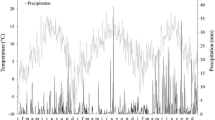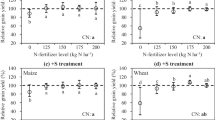Abstract
Field experiments were conducted for three years to investigate the effect of direct, residual and cumulative P application on the grain yield, P removal and P use efficiency of pigeonpea and wheat grown in rotation. Four levels of P, i.e. 0, 13, 26, and 39 kg P ha-1 were applied to either pigeonpea (Cajanus cajan L., cv. AL 15) or wheat (Triticum aestivum, cv. WL 711) or to both crops. Maximum increase in wheat grain yield ranged from 1.5 to 1.9 t ha-1 and in pigeonpea from 0.28 to 0.36 t ha-1. On average, the grain yield of pigeonpea was 8–15% higher in the residual P treatment than by direct application. In wheat, cumulative P application (to both crops) resulted in highest grain yield, but it did not differ significantly from the direct effect. However, the residual effect of P (applied to previous pigeonpea) on wheat proved to be significantly inferior to direct application. Percent recovery of P from applied fertilizer decreased with P level. Total recovery in the complete rotation was higher where P was directly applied to wheat compared to pigeonpea. The P use efficiency was also highest in the treatment comprising direct application to wheat. Pigeonpea could utilize the residual P more efficiently, indicating that fresh application to this crop can be omitted without any reduction in yield.
Similar content being viewed by others
References
Ae N, Arihara J, Okoda K, Yoshihara T, Otani T and Johansen C (1991) The role of piscidic acid secreted by pigeonpea roots grown in an Alfisol with low P fertility. InGenetic Aspects of Plant Mineral Nutrition: 4th Int Symp Genetic Aspects Plant Nutrition, Canberra, Australia
Aulakh MS, Pasricha NS, Baddesha HS and Bahl GS (1991) Long-term effects of rate and frequency of applied P on crop yields, plant available P and recovery of fertiliser P in a peanut-wheat roration. Soil Sci 151: 317–322
Bahl GS and Singh NT (1986) Phosphorus diffusion in soils in relation to some edaphic factors and its influence on P uptake by maize and wheat. J Agric Sci (Camb), 107: 335–341
Brar SPS and Bishnoi SR (1987) Effect of temperature and soil phosphorus status on the determination of extractable phosphorus by Olsen's method-Develpment of a correction factor. Analyst 112: 917–919
Crush JR (1974) Plant growth response to vescular-arbuscular mycorrhiza VII. Growth and nodulation of some herbage legumes. New Phytol. 73: 743–748
Gill HS and Meelu OP (1983) Studies on the utilization of phosphorus and causes for its differential response in rice-wheat rotation. Plant Soil 74: 211–222
Jackson ML (1967) Soil Chemical Analysis Prentice Hall India Ltd. New Delhi
Kalra VP and Soper RJ (1968) Efficiency of rape, oats, soybeans and flax in absorbing soil and fertilizer phosphorus at seven stages of growth. Agron J 60: 209–212
Mosse B (1973) Advances in study of vesicular-arbuscular mycorrhiza. Ann. Rev. Phytopath. 11: 171–196
Ponnamperuma FN (1972) The chemistry of submerged soils. Adv Agron 24: 29–88
Rhodes LH (1980) The use of mycorrhizea in crop production system. Outlook on Agric. 10: 275–281
Sanchez PAand Salinas JG(1981) Lowinput technology formanaging Oxisols and Ultisols in tropical America. Advances Agron, 34, 279
Singh G (1996) Combined use of poultry manure and inorganic P fertilizer in relation to P availability in different soils. M. Sc. Thesis, P. A. U., Ludhiana, India
Sinha MN and Rai RN (1975) Efficiency of fertilizer utilization by wheat using 32P as a tracer. Indian J Agron 21: 180–183
Soil survey Staff (1975) Soil Taxonomy, Agric Handb. U. S. Dep. Agric. 436
Rights and permissions
About this article
Cite this article
Bahl, G., Pasricha, N. Efficiency of P utilization by pigeonpea and wheat grown in a rotation. Nutrient Cycling in Agroecosystems 51, 225–229 (1998). https://doi.org/10.1023/A:1009764503975
Issue Date:
DOI: https://doi.org/10.1023/A:1009764503975




